In this section, we'll use our results on maxima and minima for functions to do word problems which involve finding the largest or smallest value of lengths, areas, volumes, costs, and so on. The hardest part of doing these problems is setting up the appropriate equations; the calculus part is relatively simple.
Some of these problems involve finding an absolute max or min on a closed interval. We know that to do this, we find the critical points on the interval, then test the endpoints and the critical points in the original function.
In some situations, the quantity we're trying to maximize or minimize varies over a non-closed interval. In those cases, the following theorem is often useful.
Theorem. Suppose a function f has its second
derivative ![]() defined on an interval
defined on an interval ![]() . Suppose that
. Suppose that ![]() , and that c is
the only critical point on the interval
, and that c is
the only critical point on the interval ![]() .
.
(a) If c is a local max, then it is an absolute max.
(b) If c is a local min, then it is an absolute min. ![]()
The key in applying the theorem is that there is only one critical point.
Example. A rectangular pen consists of two identical sections separated by a fence. 120 feet of fence is used for the outside of the pen and the dividing fence. What dimensions for each section produce the pen of largest area?
Let each section be x feet in width and y feet in height.
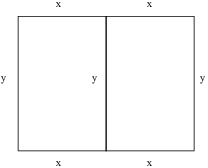
The total area is
![]()
Since 120 feet of fence are available,

Plug this into ![]() :
:
![]()
The endpoints are given by the extreme cases ![]() and
and ![]() ; note that
; note that ![]() gives
gives
![]()
Differentiate:
![]()
Set ![]() and solve for x:
and solve for x:


The maximum occurs when ![]() . In this case,
. In this case,
![]()
Example. A rectangular sheet of cardboard is 15 wide and 24 inches high. Squares with sides of length x are cut out of each corner. The four resulting tabs are folded up to make a rectangular box (with no top). Find the value of x which gives the box of largest volume.
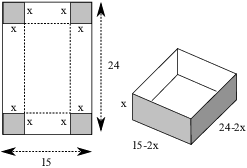
The base of the box is ![]() by
by ![]() , and the height is x. Hence, the volume is
, and the height is x. Hence, the volume is
![]()
The endpoints are ![]() (cut no squares out) and
(cut no squares out) and ![]() (cut halfway from the bottom to the top).
Obviously, these endpoints give volume 0, but it means that V is
defined on a closed interval. So I just need to test the critical
points on the interval and find the one that gives a max.
(cut halfway from the bottom to the top).
Obviously, these endpoints give volume 0, but it means that V is
defined on a closed interval. So I just need to test the critical
points on the interval and find the one that gives a max.
Differentiate:
![]()
The roots are ![]() and
and ![]() .
.
Now ![]() is greater than
is greater than ![]() , so it's outside the interval. So I only
need to consider the other root
, so it's outside the interval. So I only
need to consider the other root ![]() .
.

Thus, ![]() maximimizes the volume.
maximimizes the volume.![]()
Example. A rectangular poster is printed on a piece of cardboard with area 1200 square inches. The printed region is a rectangular region centered on the cardboard. There are unprinted (blank) margins of width 3 inches on the left and right of the printed region, and width 4 inches on the top and bottom of the printed region.
What dimensions for the printed region maximize its area?
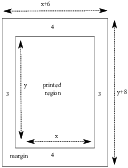
Suppose the printed area is x by y. Its area is
![]()
Since there are margins of width 3 on the left and right, and margins of width 4 on top and bottom, the area of the cardboard is
![]()
Solving for y yields
![]()
Plug this into the expression for A to obtain
![]()
The extreme cases are ![]() and
and ![]() . If
. If ![]() , then
, then
![]()
So the endpoints are ![]() and
and ![]() . (These make the area of the printed region 0, so
they obviously don't give the maximum!)
. (These make the area of the printed region 0, so
they obviously don't give the maximum!)
Compute the derivative:
![]()
Find the critical points:
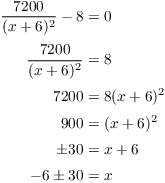
Since x is a length, it can't be negative, so take the plus sign. This gives
![]()
Plug this into ![]() to get
to get
![]() .
.

This shows that ![]() and
and ![]() maximize the area of the printed region.
maximize the area of the printed region.![]()
Example. Find the point on the line ![]() which is closest to the point
which is closest to the point ![]() .
.
The distance from ![]() to
to ![]() is
is
![]()
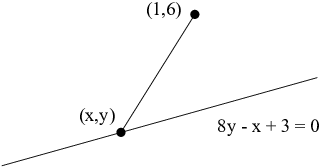
I want the point ![]() for which the distance is
smallest.
for which the distance is
smallest.
Since smaller numbers give smaller squares and vice versa, I can find where the square of the distance is smallest:
![]()
This allows me to remove the square root, and will make differentiation easier.
The line is ![]() . Solving for x gives
. Solving for x gives ![]() . Plug this into the equation for s:
. Plug this into the equation for s:
![]()
There are no restrictions on x, so I'll use the Second Derivative Test. Differentiate (noting that the variable is y):
![]()
![]()
Set ![]() to find the critical points:
to find the critical points:

This gives
![]()
Now ![]() , so
, so ![]() is a local min.
Since it's the only critical point, it's an absolute min.
is a local min.
Since it's the only critical point, it's an absolute min.![]()
Example. The volume of a circular cylinder
(with a top and a bottom) is ![]() . What values for
the radius r and the height h give the smallest total surface area
(the area of the side plus the area of the top plus the area of the
bottom)?
. What values for
the radius r and the height h give the smallest total surface area
(the area of the side plus the area of the top plus the area of the
bottom)?
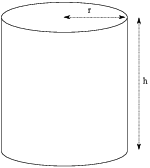
The area of the side is ![]() , the area of
the top is
, the area of
the top is ![]() , and the area of the bottom is
, and the area of the bottom is
![]() .
.
The total surface area is
![]()
The volume is
![]()
Solving for h gives ![]() . Plug this
into A:
. Plug this
into A:
![]()
The only restriction on r is ![]() . Hence, r is not
restricted to a closedinterval
. Hence, r is not
restricted to a closedinterval ![]() . Therefore,
I'll use the Second Derivative Test.
. Therefore,
I'll use the Second Derivative Test.
Compute ![]() and
and ![]() :
:
![]()
![]()
Set ![]() and solve for r:
and solve for r:
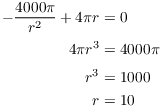
This gives ![]() .
.
Now
![]()
Hence, ![]() is a local min. Since it's the only
critical point, it's an absolute min.
is a local min. Since it's the only
critical point, it's an absolute min.![]()
Example. A cylindrical can with a top and a
bottom is made with ![]() square inches of sheet
metal, with no waste. What dimensions for the radius r and the height
h give the can of largest volume?
square inches of sheet
metal, with no waste. What dimensions for the radius r and the height
h give the can of largest volume?
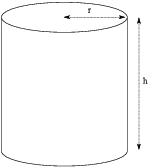
![]()
The area of the top is ![]() , the area of the
bottom is
, the area of the
bottom is ![]() , and the area of the side is
, and the area of the side is ![]() . So the total area is
. So the total area is
![]()
Solve the equation for h:
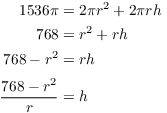
Substitute in V:
![]()
![]() is ruled out, because it would cause
division by 0 in the equation for h. There is no other restriction on
r, except that it should be positive. Since V is not restricted to a
closed interval
is ruled out, because it would cause
division by 0 in the equation for h. There is no other restriction on
r, except that it should be positive. Since V is not restricted to a
closed interval ![]() , I'll use the Second
Derivative Test.
, I'll use the Second
Derivative Test.
Compute the derivatives:
![]()
![]()
Find the critical points:
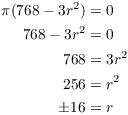
Since r can't be negative (as it's the radius of a cylinder), I get
![]() . Then
. Then
![]()
The second derivative is
![]()
Thus, ![]() is a local max. Since it's the only
critical point, it's an absolute max.
is a local max. Since it's the only
critical point, it's an absolute max.![]()
Example. Find the positive number for which the sum of 5 times the number and 320 times its reciprocal is smallest.
Let x be the number. The sum of 5 times the number and 320 times its reciprocal is
![]()
The only restriction on x is ![]() . Since x is not
restricted to a closed interval
. Since x is not
restricted to a closed interval ![]() , I'll use the Second Derivative Test.
, I'll use the Second Derivative Test.
Differentiate:
![]()
![]()
Find the critical points by setting ![]() :
:
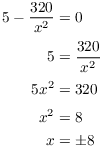
Since ![]() , I get
, I get ![]() . Plug this into the Second Derivative:
. Plug this into the Second Derivative:
![]()
Hence, ![]() is a local min. Since it's the only
critical point, it's an absolute min.
is a local min. Since it's the only
critical point, it's an absolute min.![]()
Example. A rectangular box with a square bottom and no top is made with 1200 square inches of cardboard. What values of the length x of a side of the bottom and the height y give the box with the largest volume?
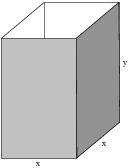
The volume is
![]()
The area of the 4 sides is ![]() , and the area of
the bottom is
, and the area of
the bottom is ![]() . So
. So
![]()
Solving for y gives
![]()
Plug this into V and simplify:
![]()
Note that ![]() , since
, since ![]() plugged into
plugged into ![]() gives
gives
![]() a contradiction. So the only restriction on
x is that
a contradiction. So the only restriction on
x is that ![]() .
.
Since x is not restricted to a closed interval ![]() , I'll use the Second Derivative Test.
, I'll use the Second Derivative Test.
Compute the derivatives:
![]()
![]()
Find the critical points:
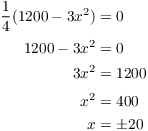
Since x is a length, it must be positive, so ![]() . This gives
. This gives
![]()
Plug ![]() into the Second Derivative:
into the Second Derivative:
![]()
![]() is a local max, but it's the only critical
point, so it's an absolute max.
is a local max, but it's the only critical
point, so it's an absolute max.![]()
Example. A rectangular box with a square bottom and no top has a volume of 2048 cubic inches. What values of the length x of a side of the bottom and the height y give the box with the smallest total surface area (the area of the bottom plus the area of the sides)?
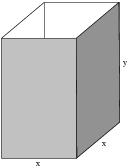
The area of the 4 sides is ![]() , and the area of
the bottom is
, and the area of
the bottom is ![]() . So the total area is
. So the total area is
![]()
The volume is
![]()
Solving for y gives
![]()
Plug this into A and simplify:
![]()
Note that ![]() , since
, since ![]() plugged into
plugged into ![]() gives
gives ![]() , a contradiction. So the only restriction
on x is that
, a contradiction. So the only restriction
on x is that ![]() .
.
Since x is not restricted to a closed interval ![]() , I'll use the Second Derivative Test.
, I'll use the Second Derivative Test.
Compute the derivatives:
![]()
![]()
Find the critical points:
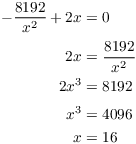
![]() gives
gives
![]()
Plug ![]() into the Second Derivative:
into the Second Derivative:
![]()
![]() is a local min, but it's the only critical
point, so it's an absolute min.
is a local min, but it's the only critical
point, so it's an absolute min.![]()
Example. A rectangular box is made with cardboard. It has no top, and consists of two identical partitions separated by a common wall. Each partition has a square bottom which is x inches by x inches, and the height of the box is y inches. If the volume of the whole box is 10584 cubic inches, what values for x and y minimize the total amount of cardboard used (for the bottom, the four sides, and the divider that separates the partitions)?
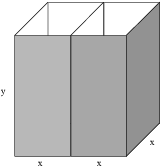
The area of the bottom is ![]() .
.
The front and back are each ![]() by y, so they have a
total area of
by y, so they have a
total area of ![]() .
.
The right side, left side, and the middle partition are each x by y,
so they have a total area of ![]() .
.
Therefore, the total area (the total amount of cardboard used) is
![]()
The total volume is
![]()
Solving this equation for y gives
![]()
Plug this into A and simplify:
![]()
The extreme case ![]() is ruled out, because it
causes division by 0 in the equation for A. Thus, x is not restricted
to a closed interval
is ruled out, because it
causes division by 0 in the equation for A. Thus, x is not restricted
to a closed interval ![]() , and I'll use the
Second Derivative Test.
, and I'll use the
Second Derivative Test.
Differentiate:
![]()
![]()
Find the critical points by setting ![]() and solving for x:
and solving for x:
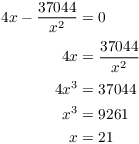
This gives
![]()
Do the Second Derivative Test:
![]()
Therefore, ![]() is a local min. Since it's the
only critical point, it's an absolute min.
is a local min. Since it's the
only critical point, it's an absolute min.![]()
Example. A rectangular box with no top has two identical partitions separated by a common wall. Each partition has a square bottom. If 2400 square inches of cardboard are used with no waste to construct the box, what dimensions yield the box with the largest (total) volume?
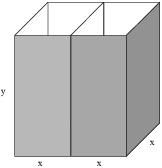
Suppose the base of each partition is x by x and the height is y. The volume is
![]()
The area of the bottom is ![]() , the area of the
front is
, the area of the
front is ![]() , the area of the back is
, the area of the back is ![]() , the area of the left side is
, the area of the left side is ![]() , the area of the right side is
, the area of the right side is ![]() , and the area of the divider that separates the two
partitions is
, and the area of the divider that separates the two
partitions is ![]() . The total area is
. The total area is
![]()
Solving for y yields ![]() .
Plug this into the volume equation and simplify:
.
Plug this into the volume equation and simplify:
![]()
x can't be 0, since ![]() causes division by 0 in the
formula for y. Since x is a length, it must be positive. So
causes division by 0 in the
formula for y. Since x is a length, it must be positive. So ![]() , and there is no other restriction on x. Since x is
not restricted to a closed interval
, and there is no other restriction on x. Since x is
not restricted to a closed interval ![]() , I'll use the Second Derivative Test.
, I'll use the Second Derivative Test.
Differentiate:
![]()
![]()
Find the critical points by setting ![]() :
:
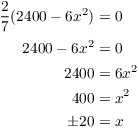
Since x must be positive, I get ![]() . This gives
. This gives
![]()
Plug ![]() into
into ![]() :
:
![]()
Hence, ![]() is a local max. Since it's the
only critical point, it's an absolute max.
is a local max. Since it's the
only critical point, it's an absolute max.![]()
Copyright 2018 by Bruce Ikenaga